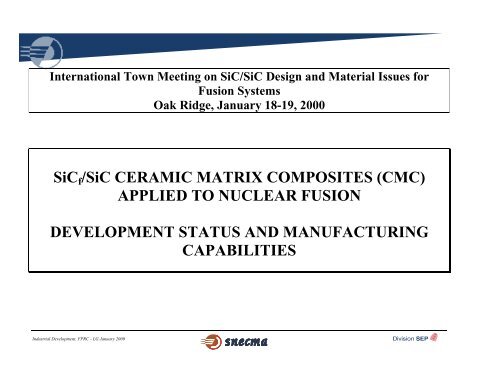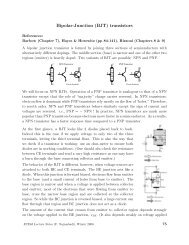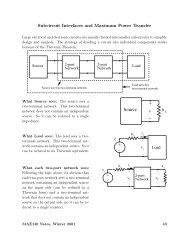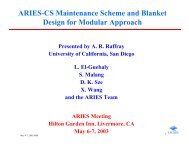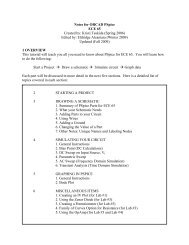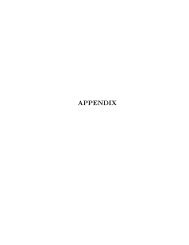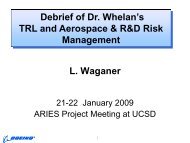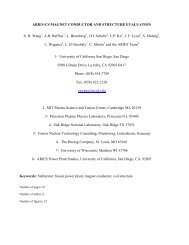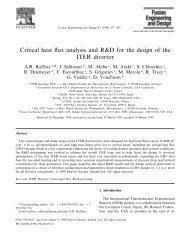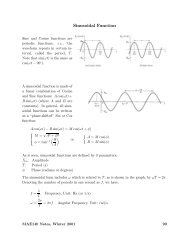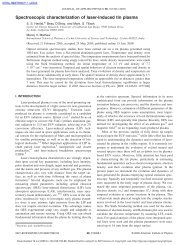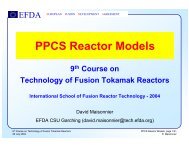SiCf/SiC CERAMIC MATRIX COMPOSITES (CMC) APPLIED TO ...
SiCf/SiC CERAMIC MATRIX COMPOSITES (CMC) APPLIED TO ...
SiCf/SiC CERAMIC MATRIX COMPOSITES (CMC) APPLIED TO ...
Create successful ePaper yourself
Turn your PDF publications into a flip-book with our unique Google optimized e-Paper software.
International Town Meeting on <strong>SiC</strong>/<strong>SiC</strong> Design and Material Issues for<br />
Fusion Systems<br />
Oak Ridge, January 18-19, 2000<br />
<strong>SiC</strong> f /<strong>SiC</strong> <strong>CERAMIC</strong> <strong>MATRIX</strong> <strong>COMPOSITES</strong> (<strong>CMC</strong>)<br />
<strong>APPLIED</strong> <strong>TO</strong> NUCLEAR FUSION<br />
DEVELOPMENT STATUS AND MANUFACTURING<br />
CAPABILITIES<br />
Industrial Development. FPRC - LG January 2000
SNECMA's <strong>SiC</strong> f /<strong>SiC</strong> <strong>COMPOSITES</strong> DEVELOPMENTS <strong>APPLIED</strong> <strong>TO</strong><br />
NUCLEAR FUSION : history and Snecma's contribution<br />
As a world leader in the field of <strong>CMC</strong> materials, SNECMA has been provided his expertise since<br />
1990 for the development of specific <strong><strong>SiC</strong>f</strong>/<strong>SiC</strong> composites grades materials tailored to the<br />
requirements of nuclear fusion.<br />
These activities, developed within the European Breeding Blanket Concept for the Fusion Power<br />
Reactor Program of the EEC, have led to the development and manufacturing of new <strong><strong>SiC</strong>f</strong>/<strong>SiC</strong><br />
materials combining a number of attractive properties :<br />
- low activation ;<br />
- good resistance to shocks and heat cycling ;<br />
- high mechanical properties to temperatures of over 1000°C ;<br />
- possibility to manufacture some complex shapes.<br />
SNECMA additionally offers :<br />
- the largest industrial facilities worldwide for the manufacturing of <strong><strong>SiC</strong>f</strong>/<strong>SiC</strong> composites parts ;<br />
- a complete assistance in design, modelisation, calculation and high temperature<br />
characterisation activities.<br />
Industrial Development. FPRC - LG January 2000
SNECMA's <strong>SiC</strong> f /<strong>SiC</strong> <strong>COMPOSITES</strong> DEVELOPMENTS <strong>APPLIED</strong> <strong>TO</strong><br />
NUCLEAR FUSION : OVERVIEW AND PRODUCTS PORTFOLIO.<br />
Improved interlaminar<br />
shear strengh<br />
CERASEP N2-1<br />
CERASEP N3-1<br />
Nicalon fibre<br />
2D texture<br />
<strong>SiC</strong> ICVI matrix<br />
Nicalon fibre<br />
Guipex 3D texture<br />
<strong>SiC</strong> ICVI matrix<br />
Increased working temperature<br />
Improved thermal conductivity<br />
CERASEP N4-1<br />
Hi-Nicalon fibre<br />
Guipex 3D<br />
3D <strong>SiC</strong> ICVI matrix<br />
Better behaviour under irradiation<br />
Further developments<br />
with high purity fibres<br />
upon request<br />
Industrial Development. FPRC - LG January 2000
SNECMA's <strong>SiC</strong> f /<strong>SiC</strong> <strong>COMPOSITES</strong> DEVELOPMENTS <strong>APPLIED</strong> <strong>TO</strong><br />
NUCLEAR FUSION : MANUFACTURING CAPABILITIES.<br />
GEOMETRICAL POSSIBILITIES :<br />
Guipex 3D<br />
Plates<br />
s<br />
Opened shell<br />
3D complex parts<br />
With curve radius > 1.5 X texture thickness<br />
LINKS :<br />
Brasing technique<br />
Common<br />
Rivet<br />
Screw<br />
Advanced<br />
Stitching<br />
Sticking of preforms and co-infiltration<br />
Industrial Development. FPRC - LG January 2000
SNECMA's <strong>SiC</strong> f /<strong>SiC</strong> <strong>COMPOSITES</strong> . MANUFACTURING MEANS.<br />
Full texture manufacturing shops capable of 2D, 3D and 4D textures fabrication.<br />
Flat panels (width from 500 to 2600mm, length from 500 to 6000mm), cylindrical<br />
and conical means (up to 2600mm diameter).<br />
Largest densification furnaces worldwide (up to 2,5 meters diameter).<br />
Isothermal Chemical Vapor Infiltration process (<strong>SiC</strong> and PyC matrix).<br />
Resin and pitch impregnation units, carbonization furnaces.<br />
Full integrated design, modelisation, process R&D and composite material expertise<br />
enabling the combination of the above industrial means according to applications<br />
requirements.<br />
World leading expertise and facilities in thermo-mecanical characterization.<br />
Industrial Development. FPRC - LG January 2000
SNECMA's <strong>SiC</strong> f /<strong>SiC</strong> <strong>COMPOSITES</strong> DEVELOPMENTS <strong>APPLIED</strong> <strong>TO</strong><br />
NUCLEAR FUSION : NEXT FORESEEN DEVELOPMENTS.<br />
Objectives : - improve thermal conductivity ;<br />
- improve the irradiation behavior.<br />
Irradiation behavior : improve the purity of the material.<br />
Use of new stoechiometric fibers<br />
Thermal conductivity : decrease the porosity of the material.<br />
New matrix grade embedding siliconization : RSG (Reactive Siliconized Grade),<br />
<strong>SiC</strong> f /<strong>SiC</strong> + Si, combining the superior mechanical characteristics provided by the<br />
CVI matrix with the good thermal conductivity properties generated by the<br />
siliconization.<br />
Industrial Development. FPRC - LG January 2000
SNECMA's <strong>SiC</strong> f /<strong>SiC</strong> <strong>COMPOSITES</strong> <strong>APPLIED</strong> <strong>TO</strong> NUCLEAR FUSION :<br />
MATERIAL MEASURED PROPERTIES.<br />
Temperature CERASEP N2-1 CERASEP N3-1<br />
Density RT > 2.4 g/cm 3 > 2.4 g/cm 3<br />
Porosity RT 10 % 10 %<br />
Fibre content RT 40 % 40 %<br />
Tensile stress (in plane) RT 285 Mpa 300 Mpa<br />
Tensile strain (in plane) RT 0.75 % 0.80 %<br />
Tensile modulus (in plane) RT 200 Mpa 200 Mpa<br />
Translaminar shear stress RT 200 Mpa 200 Mpa<br />
Thermal conductivity<br />
(through thickness)<br />
RT<br />
800°C<br />
1000°C<br />
9 W/m.K<br />
5.8 W/m.K<br />
5.7 W/m.K<br />
13 W/m.K<br />
7.6 W/m.K<br />
7.5 W/m.K<br />
CTE (in plane) 1000°C 4.10 -6 /K 4.10 -6 /K<br />
Note : CERASEP® N4-1, including Hi-Nicalon fibres, is not caracterized yet. Samples produced<br />
in 1999.<br />
Industrial Development. FPRC - LG January 2000


